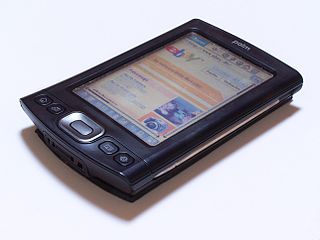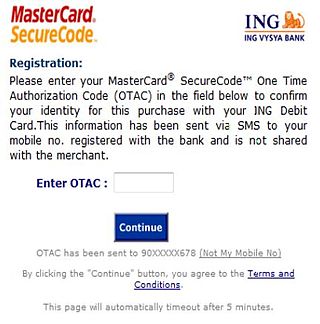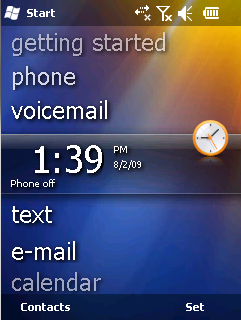
A personal digital assistant (PDA) is a multi-purpose mobile device which functions as a personal information manager. PDAs have been mostly displaced by the widespread adoption of highly capable smartphones, in particular those based on iOS and Android, and thus saw a rapid decline in use after 2007.

Mobile computing is human–computer interaction in which a computer is expected to be transported during normal usage and allow for transmission of data, which can include voice and video transmissions. Mobile computing involves mobile communication, mobile hardware, and mobile software. Communication issues include ad hoc networks and infrastructure networks as well as communication properties, protocols, data formats, and concrete technologies. Hardware includes mobile devices or device components. Mobile software deals with the characteristics and requirements of mobile applications.

A QR code is a type of two-dimensional matrix barcode, invented in 1994, by Japanese company Denso Wave for labelling automobile parts. It features black squares on a white background with fiducial markers, readable by imaging devices like cameras, and processed using Reed–Solomon error correction until the image can be appropriately interpreted. The required data are then extracted from patterns that are present in both the horizontal and the vertical components of the QR image.

A one-time password (OTP), also known as a one-time PIN, one-time authorization code (OTAC) or dynamic password, is a password that is valid for only one login session or transaction, on a computer system or other digital device. OTPs avoid several shortcomings that are associated with traditional (static) password-based authentication; a number of implementations also incorporate two-factor authentication by ensuring that the one-time password requires access to something a person has as well as something a person knows.

Windows Mobile is a discontinued mobile operating system developed by Microsoft for smartphones and personal digital assistants.
Object hyperlinking is a term that refers to extending the Internet to objects and locations in the real world. Object hyperlinking aims to extend the Internet to the physical world by attaching tags with URLs to tangible objects or locations. These object tags can then be read by a wireless mobile device and information about objects and locations retrieved and displayed.

Digital signage is a segment of electronic signage. Digital displays use technologies such as LCD, LED, projection and e-paper to display digital images, video, web pages, weather data, restaurant menus, or text. They can be found in public spaces, transportation systems, museums, stadiums, retail stores, hotels, restaurants and corporate buildings etc., to provide wayfinding, exhibitions, marketing and outdoor advertising. They are used as a network of electronic displays that are centrally managed and individually addressable for the display of text, animated or video messages for advertising, information, entertainment and merchandising to targeted audiences.
Mobile marketing is a multi-channel online marketing technique focused at reaching a specific audience on their smartphones, feature phones, tablets, or any other related devices through websites, e-mail, SMS and MMS, social media, or mobile applications. Mobile marketing can provide customers with time and location sensitive, personalized information that promotes goods, services, appointment reminders and ideas. In a more theoretical manner, academic Andreas Kaplan defines mobile marketing as "any marketing activity conducted through a ubiquitous network to which consumers are constantly connected using a personal mobile device".
Proximity marketing is the localized wireless distribution of advertising content associated with a particular place. Transmissions can be received by individuals in that location who wish to receive them and have the necessary equipment to do so.
A home server is a computing server located in a private computing residence providing services to other devices inside or outside the household through a home network or the Internet. Such services may include file and printer serving, media center serving, home automation control, web serving, web caching, file sharing and synchronization, video surveillance and digital video recorder, calendar and contact sharing and synchronization, account authentication, and backup services. In the recent times, it has become very common to run literally hundreds of applications as containers, isolated from the host operating system.
Mobile tagging is the process of providing data read from tags for display on mobile devices, commonly encoded in a two-dimensional barcode, using the camera of a camera phone as the reader device. The contents of the tag code is usually a URL for information addressed and accessible through Internet.

A mobile phone is a portable telephone that can make and receive calls over a radio frequency link while the user is moving within a telephone service area, as opposed to a fixed-location phone. The radio frequency link establishes a connection to the switching systems of a mobile phone operator, which provides access to the public switched telephone network (PSTN). Modern mobile telephone services use a cellular network architecture, and therefore mobile telephones are called cellphones in North America. In addition to telephony, digital mobile phones support a variety of other services, such as text messaging, multimedia messaging, email, Internet access, short-range wireless communications, satellite access, business applications, payments, multimedia playback and streaming, digital photography, and video games. Mobile phones offering only basic capabilities are known as feature phones ; mobile phones that offer greatly advanced computing capabilities are referred to as smartphones.
The W3C Geolocation API is an effort by the World Wide Web Consortium (W3C) to standardize an interface to retrieve the geographical location information for a client-side device. It defines a set of objects, ECMAScript standard compliant, that executing in the client application give the client's device location through the consulting of Location Information Servers, which are transparent for the application programming interface (API). The most common sources of location information are IP address, Wi-Fi and Bluetooth MAC address, radio-frequency identification (RFID), Wi-Fi connection location, or device Global Positioning System (GPS) and GSM/CDMA cell IDs. The location is returned with a given accuracy depending on the best location information source available.

Mobile technology is the technology used for cellular communication. Mobile technology has evolved rapidly over the past few years. Since the start of this millennium, a standard mobile device has gone from being no more than a simple two-way pager to being a mobile phone, GPS navigation device, an embedded web browser and instant messaging client, and a handheld gaming console. Many experts believe that the future of computer technology rests in mobile computing with wireless networking. Mobile computing by way of tablet computers is becoming more popular. Tablets are available on the 3G and 4G networks.

A smart TV, also known as a connected TV (CTV), is a traditional television set with integrated Internet and interactive Web 2.0 features that allow users to stream music and videos, browse the internet, and view photos. Smart TVs are a technological convergence of computers, televisions, and digital media players. Besides the traditional functions of television sets provided through traditional broadcasting media, these devices can provide access to over-the-top media services such as streaming television and internet radio, along with home networking access.
Mobile Business Intelligence is defined as “Mobile BI is a system comprising both technical and organizational elements that present historical and/or real-time information to its users for analysis on mobile devices such as smartphones and tablets, to enable effective decision-making and management support, for the overall purpose of increasing firm performance.”. Business intelligence (BI) refers to computer-based techniques used in spotting, digging-out, and analyzing business data, such as sales revenue by products and/or departments or associated costs and incomes.
A second screen involves the use of a computing device to provide a different viewing experience for content on another device.

Far-Play is a software platform developed at the University of Alberta, for creating location-based, scavenger-hunt style games which use the GPS and web-connectivity features of a player's smartphone. According to the development team, "our long-term objective is to develop a general framework that supports the implementation of AARGs that are fun to play and also educational". It utilizes Layar, an augmented reality smartphone application, QR codes located at particular real-world sites, or a phone's web browser, to facilitate games which require players to be in close physical proximity to predefined "nodes". A node, referred to by the developers as a Virtual Point of Interest (vPOI), is a point in space defined by a set of map coordinates; fAR-Play uses the GPS function of a player's smartphone — or, for indoor games, which are not easily tracked by GPS satellites, specially-created QR codes— to confirm that they are adequately near a given node. Once a player is within a node's proximity, Layar's various augmented reality features can be utilized to display a range of extra content overlaid upon the physical play-space or launch another application for extra functionality.

Kubity is a cloud-based 3D communication tool that works on desktop computers, the web, smartphones, tablets, augmented reality gear, and virtual reality glasses. Kubity is powered by several proprietary 3D processing engines including "Paragone" and "Etna" that prepare the 3D file for transfer over mobile devices.
Remote SIM provisioning is a specification realized by GSMA that allows consumers to remotely activate the subscriber identity module (SIM) embedded in a portable device such as a smart phone, smart watch, fitness band or tablet computer. The specification was originally part of the GSMA's work on eSIM and it is important to note that remote SIM provisioning is just one of the aspects that this eSIM specification includes. The other aspects being that the SIM is now structured into "domains" that separate the operator profile from the security and application "domains". In practise "eSIM upgrade" in the form of a normal SIM card is possible or eSIM can be included into an SOC. The requirement of GSMA certification is that personalisation packet is decoded inside the chip and so there is no way to dump Ki, OPc and 5G keys. Another important aspect is that the eSIM is owned by the enterprise, and this means that the enterprise now has full control of the security and applications in the eSIM, and which operators profiles are to be used.










